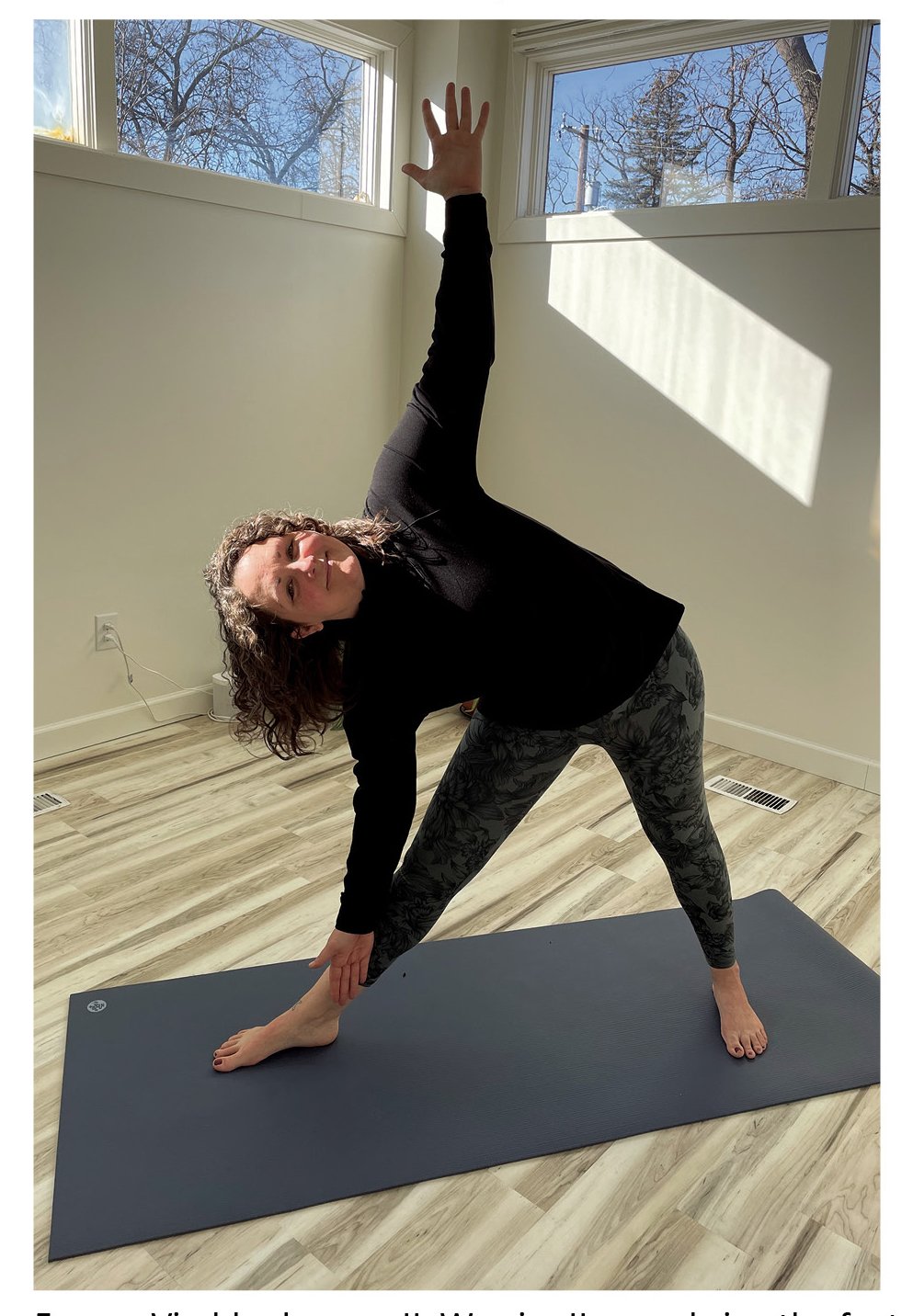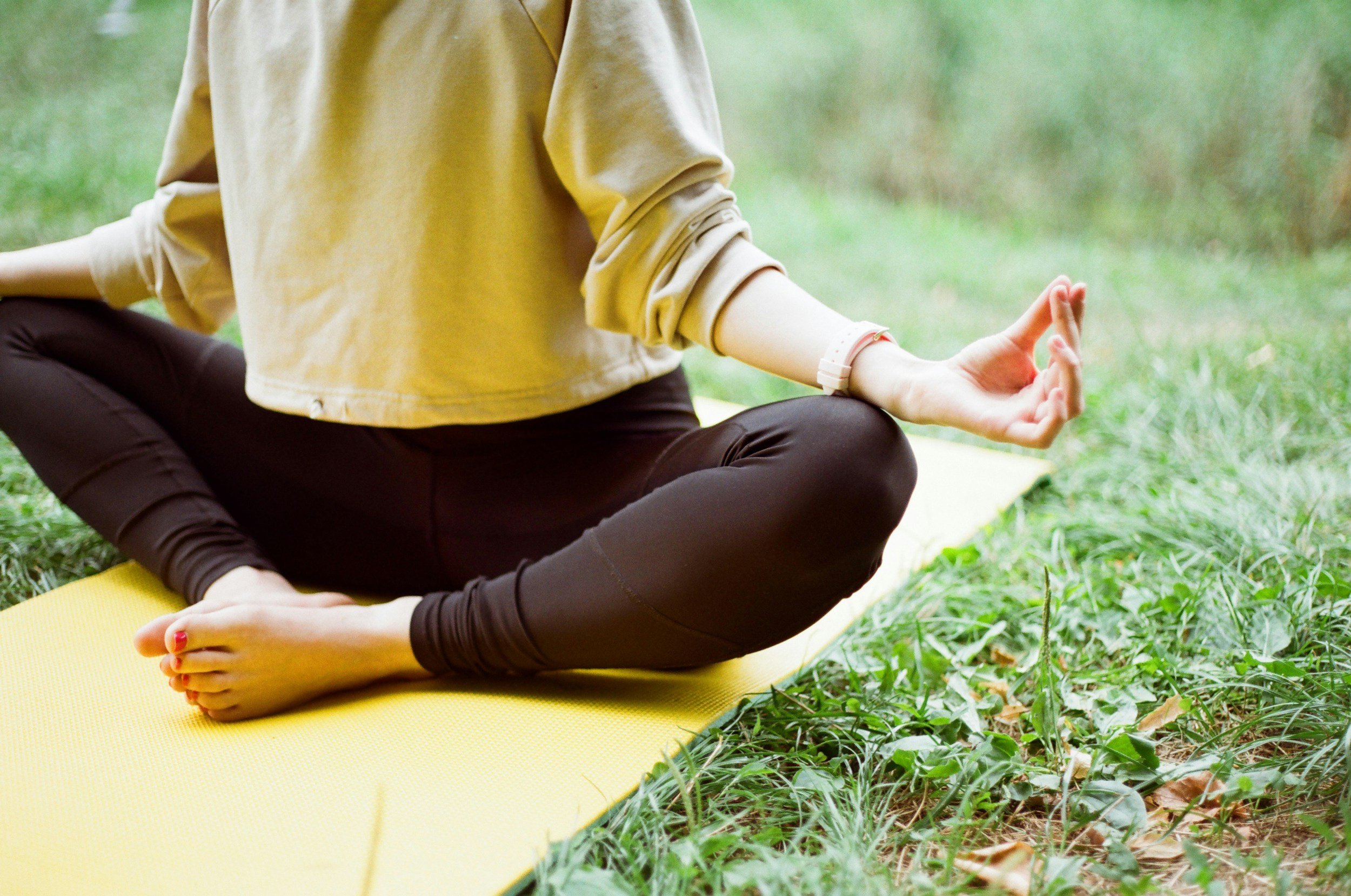Namaste Katie,
I have, lovingly, been practicing a lot of restorative yoga over the last few years. I am now engaging in some more active practices. As I make this transition is there a particular posture that you recommend to activate the muscles and keep me focused?
Liza, Ann Arbor
Hi Liza,
I love this question. I too, have spent a lot of time lately in restorative practices, the desire to slow down during external chaos is important to tap into. It is also important to listen to your body and spirit in terms of adding asana with more activity, more agni: fire. A favorite of mine is Trikonasana, Triangle pose. Trikonasana is a pose that engages a great number of muscles in the body and can be modified to your heart’s content to meet our own unique needs.
From a Virabhadrasana II, Warrior II pose, bring the feet slightly closer together. We will straighten the front leg while keeping the front knee soft. Inhale the arms to about shoulder height, exhale and kick the back hip back while reaching the front hand forward and allowing it to reach to the area that feels right. For some of us that front arm will rest on the thigh, others the inside of the shin, others on the floor. Some of us may wish to use a block under the hand to support the pose. The top arm may reach toward the sky, as pictured, or it may rest at the hip. For the gaze, we have the option for a neutral neck, or to take the gaze toward the sky or the floor. As we make adjustments with the arms and neck, we want to check with the heart center and assure that it is not tipping toward the floor.
Trikonasana activates muscles through the feet and legs, the glutes, the core and back, and all through the arms. This pose can also take time getting comfortable in, so as you took the time in restorative classes, take time with Trikonasana, see where it opens up for you, and see where it challenges you. These are great areas of focus, as long as there is no pain.
Namaste Katie,
I have found myself overwhelmed with grief of an oftentimes global scale. My partner is struggling to understand why these events get to me, and I have stopped explaining it, and have turned to meditation and similar practices to try to understand my feelings. Do you have any recommendations for particular practices?
Dale, Ann Arbor
Hello Dale,
Being sensitive to global loss and shared humanity is a large component of compassion. Allowing it to impact us shows a connection to others and recognition of the threads that bind the human spirit. When it starts to impact your daily life, it certainly is worth talking to someone or taking a look at any other factors. Yoga, and other contemplative practices, address common humanity in every practice, as the idea that we all share a universal consciousness is core to the practice. A wonderful meditation that may support the journey that you are on is the practice of Lovingkindness.
In The Mind Self-Compassion Workbook by Dr. Kristin Neff and Dr. Christopher Germer, among the various methods explained, they discuss the benefits of practicing lovingkindness for ourselves and. Drs. Neff and Germer did not invent Lovingkindness practices. In fact, these meditations and practices have been in use for thousands of years; however, they have been studying the impact of many practices in relationship to self-compassion on individuals and communities.
The most common Lovingkindness practice is to repeat four mantras, and this repetition can be external or internal, and at times a combination of both. We start with,” May I be happy. May I be peaceful. May I be healthy. May I live with ease.” Repeat several times slowly, softly. If we are sending the lovingkindness to a specific person, we gently replace the ‘I’ with ‘you’ or the individual’s name. For the global perspective you were describing, we broaden the lovingkindness even further: “May we be healthy. May we be peaceful. May we be healthy. May we live with ease.” This is a beautiful daily practice to help soften grief and create, or enhance, feelings of connection. May you feel peace.
Namaste Katie,
I have been following along with all of the breath advice of late, and am enjoying those practices, as I can do many of them while on most remote meetings. The last one shared (Mountain Breath) was a little more challenging to practice virtually while working! Do you have any that help with attention while present for work?
Keisha, Superior Township
Dear Keisha,
This is an amazing question! And yes, Mountain Breath would be an interesting look at a work meeting whether you were remote or in person. One consistent breath that is appropriate for most locations is three-part breathing. As with all pranayama, this breath is your own to play with, and to decide how much you want to add on.
We start by making room for the breath. This is usually finding a spot, or space, where you can find a length in the spine. Most desk chairs are not great at this, as they tilt the pelvis in a way that rounds the back. I often find that for a more neutral spine I scoot to the end of my desk chair, and let my hips find a more natural spot. This will of course be different for each of us. Some find a small pillow on the seat of the chair helpful for this as well. Once we feel good about the space we have allowed for the breath, start noticing where the base of the breath is at this time. Oftentimes, we start noticing the breath is high in the chest, perhaps right below the collar bones. Without judgment we notice, and we begin to pull the breath down into the body. Engage the diaphragm and draw the breath further down in the direction of the belly button. Notice the rise and fall of the abdomen. Imagine as though air was pouring into the lungs from a beautiful pitcher. Filling the base of the lungs, the middle, and all the way to the top. We exhale in the opposite order, emptying the top, middle, base of the lungs, engaging the diaphragm at the end of the exhale to clear the last of the breath before beginning again. See how much of the journey you can follow.
As stated above, we have lots of options with this three-part breath. We can extend the breath further and deeper, or keep our breath at its resting space, and notice the action of the breath. If we are at a space in our day where we may be able to close our eyes, we can dive deeper into the internal space of the practice. If we are lengthening the breath, we can engage in that length for a few breaths and relax, then deepen again for a few breaths. We have so many opportunities to explore. This is both a wonderful mindfulness practice and a pranayama practice to engage with the breath.
Katie Hoener is a RYT 500, receiving her 200 and 500 hour trainings. She is also a Licensed Master Social Worker and a partner at Verapose Yoga in Dexter (veraposeyoga.com). Please send your own yoga questions to katie@veraposeyoga.com.
































































































































































































For the last 15 years, in the early morning between five and eight, the 200 block of South Main Street has filled with yoga practitioners who come and go before the town comes to life. It’s a diverse group, ranging from those in their teens to those in their 80s, across all sorts of life situations and physical capacities. The yoga they practice is tailored to the individual. Depending on the person, the practice might include various physical asanas, breathing techniques, and meditations. What they all have in common is that they’re all part of a school, and a community organization, called Ashtanga Yoga Ann Arbor.